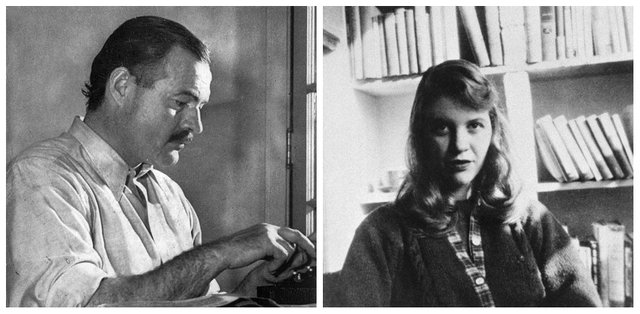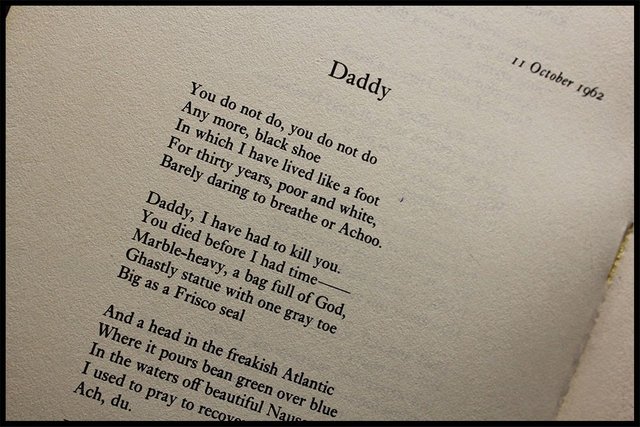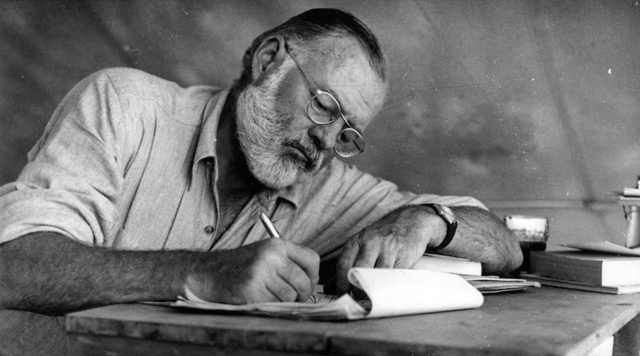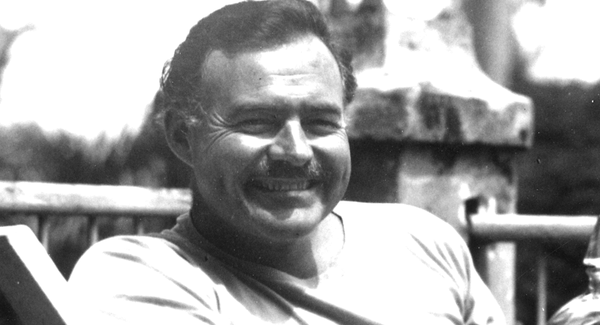ADSactly Culture - The Life of Tortured Artists #2 (Sylvia Plath & Ernest Hemingway)

Hello again, dear @adsactly readers. Last time, we spoke about the concept of “tortured artist” which seems to capture a strange fascination in our society today. But, as I pointed out in the previous post about the life of Vincent Van Gogh, this life of the tortured artist was far from a pleasant one. Even though we imagine suffering for your art to be terribly romantic, there was a lot of pain and sadness to be associated with it. None of the people on our list lived happy lives.
With that in mind, we move on to our next “tortured artist”, the poet Sylvia Plath.
2. Sylvia Plath
Reading through Sylvia Plath’s life is...chilling, to be honest. It’s a strange story and a very sad one, I believe. Sylvia began writing at a very early age, ever since she was eight years old. She also enjoyed painting and showed great promise. As a child, she’s said to have been extremely ambitious and driven.
I think her first real breaking moment was at the death of her father, with whom she had a very complex relationship. Interestingly, Otto Plath died after he had his leg amputated (as a result to a diabetes infection), which he refused to treat, being convinced he was suffering from lung cancer (a close friend of his had recently died of this). Surely, it’s a strange way to die.
This monumental event obviously shook little Sylvia’s life (she was eight years old at the time). It’s very interesting to read her poem ‘Daddy’, written in adulthood, to glimpse a fragment of the love-hate relationship she had with her father.
She viewed this moment as the end of her childhood in a way and in many ways, this may have been the catalyst for her precarious mental state and the sadness that would haunt her throughout her life.
It’s often said that writing can be very cathartic, that many writers attribute a certain therapeutic value to it. And it’s easy to see this therapy-like feeling in Plath’s writing, now known as confessional writing. It seems a shame really, such a talented woman, plagued by such terrible sadness.
Among attempts on her own life and stays in psychiatric hospitals, Plath developed her writing style, worked as an editor and met her future husband, fellow poet Ted Hughes, of whom she later wrote:
We kept writing poems to each other. Then it just grew out of that, I guess, a feeling that we both were writing so much and having such a fine time doing it, we decided that this should keep on…
But it seems their home life was not an ideal one. Hughes has been accused of abusing Sylvia many times (even by the poet herself, who blamed the miscarriage of her second child on him) and even murdering her, but it’s easy to see, really, that Sylvia was troubled and deeply unhappy before she even met Hughes, so this latter allegation seems to fall through.
The couple eventually separated in 1962, after Hughes began an affair with their tenant, Assia Wevill (who would also later commit suicide, strangely). They had two children together.
Plath seems to have suffered from a feeling of extreme loneliness and isolation. She tragically ended her own life in 1963, at the age of 30.
3. Ernest Hemingway
The reason I’m pairing these two is not only that they were both American and writers, but also because they both underwent electroshock therapy, as a way of “treating” their depression, which I find fascinating. Particularly since Hemingway shot himself only a few months afterwards.
Ernest Hemingway lived the life you think of when you think of a writer. Booze, women, stays in Paris… But what can you expect, he served in the First World War, had a tense friendship with another 20th century great, F Scott Fitzgerald, and was taken under the wing of Ezra Pound. He truly had a fascinating life.
Through most of his life, Hemingway battled a serious alcohol problem, causing irreparable damage to his own liver, as well as other health issues. He was wounded in various conflicts, accidents, crashes etc. Really, he sustained an astonishing number of injuries throughout his life – multiple concussions, broken arms and legs, spinal fracture, as well as many others.
These constant injuries only worsened his drinking, which helped him numb the pain.
He seems to have had a tumultuous private life. When he was serving in the First World War, he was badly wounded and spent a long time recovering, during which he met Agnes von Kurowsky, a nurse seven years older than him. He fell deeply in love with her and the two talked about marrying in America (Hemingway was fighting in Italy at the time). But then, Hemingway got news that Agnes had become engaged to another man and this broke his heart. What’s interesting to note here is that in his future relationships, he always followed a pattern of abandoning the women in his life before they had a chance to abandon him, like Agnes had done.
He was married four times and always, he left his previous wife with the excuse he’d fallen for the next one.
He led a very interesting life, beside his service years in the war, his journalistic career took him to Cuba and to report on the Spanish Civil War, he also had a part in WWII, he was at the bullfights in Pamplona, he seems to have lived enough for three lifetimes. All of this while having a full writing career. Unlike other artists on our list, Ernest Hemingway received appreciation and credit during his own lifetime, even being awarded the Nobel Prize. (Even though he was convinced that the erroneous report that he’d died in a plane crash a few months previous had helped get him the award)
It doesn’t seem like he suffered from major depression or any other such mental issues throughout most of his life, only towards the end. He was affected, naturally, by the many physical injuries sustained during his life and the heavy use of alcohol. He also grew very upset in the early 40s when his friends began to die one by one (WB Yeats, F Scott Fitzgerald and Gertrude Stein, to name but a few).
Towards the end, he grew increasingly paranoid and hesitant, but I suppose this was somewhat justified, given that he was indeed on the FBI watch-list (as a result of his stay in Cuba and his friendship with the Castro government). In 1960, he was hospitalized at the Mayo Clinic (to be treated for hypertension, he most likely thought) and treated with electroshock therapy (ECT). He is said to have been released “in ruins” and ended his own life less than six months after. And while the ECT may have played a part in his demise, it was also a matter of genetics for Hemingway. His father took his own life some years before, as did his brother and sister, and Ernest noted at the time that he would probably go the same way.
It was revealed in 1991 that Hemingway suffered from hemochromatosis, a genetic condition that makes it difficult for the sufferer to metabolize iron, leading to an iron accumulation in the body, which in turn leads to physical and mental deterioration.
Like many artists, Hemingway complained of the terrible loneliness that comes with great talent and that most artists seem to suffer of.
Writing, at its best, is a lonely life. Organizations for writers palliate the writer's loneliness but I doubt if they improve his writing. He grows in public stature as he sheds his loneliness and often his work deteriorates. For he does his work alone and if he is a good enough writer he must face eternity, or the lack of it, each day.
What do you think of our series so far? Who are other "tortured artists" that you consider fascinating?
Authored by @honeydue

Click on the coin to join our Discord Chat

Witness proposal is here:
Go To Steem Witness Page
In the bottom of the page type: adsactly-witness and press vote.

Use small letters and no "@" sign. Or, click here to vote directly!
Thank you!




Coolest thing I've seen all day, thanks
A heartbreaking story in these two characters. When I read it, I was invited to join in this dramatic journey of life. I could understand why they had to end their lives tragically.
In my opinion, both of them are people who have enormous love for their first love. Love that is so deep makes them feel empty when they find their partner is not what they expect. when they hope to gain loyalty in return for betrayal that makes them choose to close themselves and leave the world.
This great suffering makes them have the ability to write and pour great works, because there are so many inner experiences.
Thank you @honeydue
Thank you @adsactly
thank you steemit
Warm regard from Indonesia
I've been always fascinated about tortured artists (writers mostly) because of the relation between their devastated lives and their incredibles works. I don't know who else you have in mind and what do you exactly include in "tortured", but I'd like you to do a post about Frida Kahlo, Franz Kafka or Edgar Allan Poe. Thanks for sharing.
I am a participant of that "To give art is to give away fragments of life", this shows it, the works of an artist when they are genuine, show all their happiness and / or pain. Thanks for this post.
Sylvia Plath and Ernest Hemingway are two relevant American writers with difficult lives. The second is much more widespread and well known, among other things because he is the author of a narrative (excellent stories!, preferred by me more than his novels), which attracts the attention of the ordinary reader, a somewhat striking life (almost spectacular) and the adaptation to cinema of some of his novels (for example, *For whom do the bells ring? *, starring nothing more and nothing less than Ingrid Bergman). Hemingway's life is very intense.
Personally, I am more attracted to the poet Sylvia Plath, not only because she devotes herself to poetry (which identifies me), but also because of her more withdrawn, less public and notorious condition. Her poetry touched me deeply when I met her several years ago. In an anthology of hers that I keep, I review and find inside, among others, two poetic phrases underlined by me from her "poem "The moon and the yew", which seem to me to be very revealing of her torment: "How I would like to believe in tenderness", "I have fallen very deep". Such dramatic or tragic destinies had, for example, the American poet Anne Sexton, the Argentinean Alejandra Pizarnik or the Venezuelan Miyó Vestrini, writers whom I prefer to call "tormented",
Thank you for your informative and sensitive post, @honeydue. Greetings.
Two beautiful complicated writers.
It broke my heart that Sylvia Plath's life ended at such a tender age. 30! She had so much life ahead of her. That her beloved lovey-dovey poetic husband suddenly became her nightmare is what I find quite contradictory.
Ernest Hemingway despite being an alcohol addict is a legend. I understand his fears with women and how his experience with Agnes change everything.
Indeed, it's quite unfortunate and heartbreaking.
Beautiful analysis, well done.
Hi, @adsactly!
You just got a 0.41% upvote from SteemPlus!
To get higher upvotes, earn more SteemPlus Points (SPP). On your Steemit wallet, check your SPP balance and click on "How to earn SPP?" to find out all the ways to earn.
If you're not using SteemPlus yet, please check our last posts in here to see the many ways in which SteemPlus can improve your Steem experience on Steemit and Busy.
Seneca said: No great genius was given without any mixture of madness. Madness, and within it are the melancholic, the paranoid, the eccentric, the misfit and other "marginalized" at the edge of society, has starred in many of the most fruitful episodes of Art History, and has stigmatized many artists and marked their own understanding and acceptance of their work. As I told you in your previous delivery, Sylvia Plat's life is still a sample of the degree of suffering, but also of an artist's genius. I would like to leave here two verses from the poem Edge , which paints the image of a woman and her children in death, considered as the last poem written by Plath and some consider it more like a suicide note:
Thank you for this series, @honeydue. I am looking forward to the next installment.